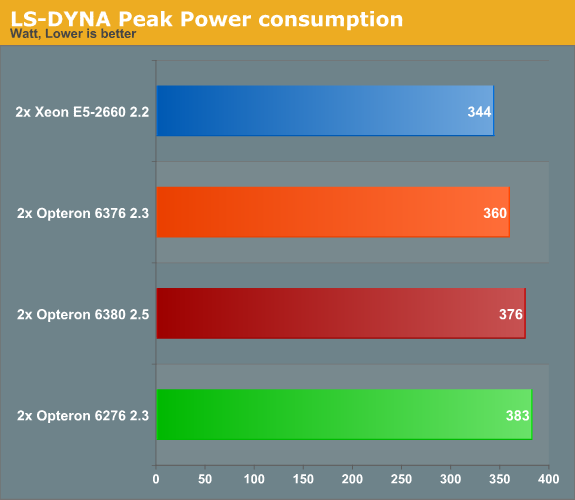The new Opteron 6300: Finally Tested!
by Johan De Gelas on February 20, 2013 12:03 AM ESTLS-DYNA Power Consumption
For HPC buyers, peak power tends to be a very important metric. As HPC systems are run at close to or equal to 100% CPU load, the energy consumption is at its peak for a long time. Peak power thus also determines the cooling and energy requirements. This is in sharp contrast with most other servers, where calculating the power and amps based on the peak load of a complete rack is considered wasteful as it is highly unlikely that all servers will hit 100% CPU load at the same time. We took the 95th percentile of our power numbers.

Note that the Xeon E5 numbers are not directly comparable to the Opteron numbers as the CPUs are tested in servers with different form factors. We will tackle that in the next test. Let us focus on the Opteron results for now.
AMD has made some real progres here. At the same clock, the total power consumption is 6% lower. Even at a 200MHz higher clock the peak power is very slightly—but consistently—lower (2%).
Of course, we also want to compare the AMD and Intel CPUs directly. To do this, we always run the fans at maximum speed. That way, the fans always consume the same amount of power. We then test with one and two CPUs, while keeping the amount of memory (64GB) the same. This way we measure how much extra power you consume at the wall when you add a second CPU. This number thus includes the voltage regulators (which can amount to up to 10% of the total server power) and the PSU inefficiency.

The Intel Xeon has a TDP of 95W, but even with a very FP intensive application it does not get anywhere near that number. About 75W out of those 94W are consumed by the CPU, as measured by our Hardware Monitoring Software that reads out the MSRs. We are still working on our version for the AMD platform (AMD's documentation is a bit late), but we estimate that the Opteron 6376 consumes about 110W and the Opteron 6380 needs about 120W. That means that AMD's top CPUs are probably consuming a bit more than their TDP indicates if you push the FP unit hard.
We also tried to measure idle power. Take the numbers with a grain of salt, but we measured about 19-20W for the Opteron 6380 (p-states disabled), 17-18W for the Opteron 6376 and 16-17W for the Xeon.










55 Comments
View All Comments
sherlockwing - Wednesday, February 20, 2013 - link
These Piledriver based Opterons look competitive but the threat of Ivy-EP is immenient. The last time Intel die-shrunk their High end platform they introduced the monsterous 10 core Westmere-EP(the current Xeon E7 lineup), I wouldn't be surprised Ivy-EP introduces 10/12 core extreme E7 Xeons as well as Octa Xeons with better performance/watt.Kevin G - Wednesday, February 20, 2013 - link
Ivy Bridge-E is indeed coming but it is looking to be 6 months out. These Opterons were shipping since November which would give them a 10 month lead time. The real question for AMD is what they'll have in response in that time frame. Steamroller based parts all look to be released in 2014. On the bright side, AMD should be pairing those chips with a new socket as DDR4 becomes available.One thing though about Ivy Bridge-E is that it will also be a socket 2011 part so migration to it should get relatively quick in comparison to the Westmere-EP to Sandybridge-E transition. The same cost savings for OEM noted in this article for socket G32 Opterons will apply to Ivy Bridge-E this time around.
Oskars Apša - Wednesday, February 20, 2013 - link
Wasn't intels 2011 socket to be only physically identical, but electrically totally redesigned?Hrel - Friday, February 22, 2013 - link
"These Opterons were shipping since November"I reject this statement. Nothing counts as being "on the market" until Anandtech has done a full review of it. That's my stance and I'm sticking to it :P
Beenthere - Wednesday, February 20, 2013 - link
...is that the 63xx series is focused primarily on micro servers where it fits well. If the just disclosed Jaguar cores are any indication of AMD products to be released this and next year, I'd say AMD is back in the game in many PC and portable markets.The only thing Ivy Bridge has going for it is reduced power but at a price penalty.
JohanAnandtech - Thursday, February 21, 2013 - link
SeaMicro was indeed one of first to use Piledriver based cores, but I don't think the Opteron 6300 is meant to be a "typical" microserver CPU. Otherwise, AMD would have focused more on low power parts. This meant to be an update for the general server market.Jovec - Wednesday, February 20, 2013 - link
... as it is showing the multi-threaded chart instead.JohanAnandtech - Wednesday, February 20, 2013 - link
Fixed. Thanks for pointing it out, always appreciated.Death666Angel - Wednesday, February 20, 2013 - link
Hey!I get a " Page Not Found" error from the Racktivity PDU link. :)
ssj3gohan - Wednesday, February 20, 2013 - link
You say that AMDs bad implementation of C6 costs them in the energy efficiency tests, but AFAIK with a low of still 10% CPU the CPU should not enter ACPI C3 (Intel C6), it will probably stay in C1e providing there is still more than enough workload to do on each OS tick.If the xeons are observed to go into ACPI C3, then that is very probably a scheduler optimization specific for intel processors, not an actual implementation problem by AMD. Balancing C-state transitions - especially complete core sleep modes like ACPI C3 - is a notoriously hard task to do because each transition also costs a certain amount of mJ that, on immediate wake, are wasted compared to just leaving the cores in C1(e)